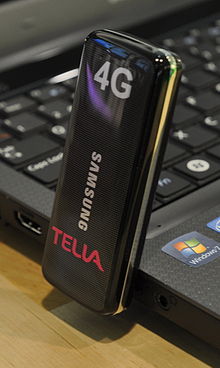4G
In the telecommunications, 4G is the fourth generation of cellular wireless standards. It is a successor to the 3G and 2G families of standards. In 2008, the ITU-R organization specified the IMT-Advanced (International Mobile Telecommunications Advanced) requirements for 4G standards, setting peak speed requirements for 4G service at 100 Mbit/s for high mobility communication (such as from trains and cars) and 1 Gbit/s for low mobility communication (such as pedestrians and stationary users).
A 4G system is expected to provide a comprehensive and secure all-IP based mobile broadband solution to laptop computer wireless modems, smartphones, and other mobile devices. Facilities such as ultra-broadband Internet access, IP telephony, gaming services, and streamed multimedia may be provided to users.
Pre-4G technologies such as mobile WiMAX and first-release Long term evolution (LTE) have been on the market since 2006 and 2009 respectively, and are often branded as 4G in marketing materials. The current versions of these technologies did not fulfill the original ITU-R requirements of data rates approximately up to 1 Gbit/s for 4G systems.
IMT-Advanced compliant versions of the above two standards are under development and called “LTE Advanced” and “WirelessMAN-Advanced” respectively. ITU has decided that “LTE Advanced” and “WirelessMAN-Advanced” should be accorded the official designation of IMT-Advanced. On December 6, 2010, ITU announced that current versions of LTE, WiMax and other evolved 3G technologies that do not fulfill "IMT-Advanced" requirements could be considered "4G", provided they represent forerunners to IMT-Advanced and "a substantial level of improvement in performance and capabilities with respect to the initial third generation systems now deployed."
In all suggestions for 4G, the CDMA spread spectrum radio technology used in 3G systems and IS-95 is abandoned and replaced byOFDMA and other frequency-domain equalization schemes. This is combined with MIMO (Multiple In Multiple Out), e.g., multiple antennas, dynamic channel allocation and channel-dependent scheduling.
The nomenclature of the generations generally refers to a change in the fundamental nature of the service, non-backwards compatible transmission technology, and new frequency bands. New generations have appeared about every ten years since the first move from 1981 analog (1G) to digital (2G) transmission in 1992. This was followed, in 2001, by 3G multi-media support, spread spectrumtransmission and at least 200 kbit/s, in 2011 expected to be followed by 4G, which refers to all-IP packet-switched networks, mobile ultra-broadband (gigabit speed) access and multi-carrier transmission
4G predecessors and discontinued candidate systems
3GPP Long Term Evolution (LTE)
The pre-4G technology 3GPP Long Term Evolution (LTE) is often branded "4G", but the first LTE release does not fully comply with the IMT-Advanced requirements. LTE has a theoretical net bit rate capacity of up to 100 Mbit/s in the downlink and 50 Mbit/s in the uplink if a 20 MHz channel is used — and more if multiple-input multiple-output (MIMO), i.e. antenna arrays, are used.
The physical radio interface was at an early stage named High Speed OFDM Packet Access(HSOPA), now named Evolved UMTS Terrestrial Radio Access (E-UTRA). The first LTE USB dongles do not support any other radio interface.
The world's first publicly available LTE service was opened in the two Scandinavian capitalsStockholm (Ericsson system) and Oslo (a Huawei system) on 14 December 2009, and branded 4G. The user terminals were manufactured by Samsung
Currently, the two publicly available LTE services in the United States are provided by MetroPCS, andVerizon Wireless. AT&T also has an LTE service in planned for deployment between mid-2011 and end of 2013, Sprint Nextel has stated it's considering switching from WiMax to LTE in the near future.
Currently, the two publicly available LTE services in the United States are provided by MetroPCS, andVerizon Wireless. AT&T also has an LTE service in planned for deployment between mid-2011 and end of 2013, Sprint Nextel has stated it's considering switching from WiMax to LTE in the near future.
Mobile WiMAX (IEEE 802.16e)
The Mobile WiMAX (IEEE 802.16e-2005) mobile wireless broadband access (MWBA) standard (also known as WiBro in South Korea) is sometimes branded 4G, and offers peak data rates of 128 Mbit/s downlink and 56 Mbit/s uplink over 20 MHz wide channels
The world's first commercial mobile WiMAX service was opened by KT in Seoul, South Korea on 30 June 2006.
Sprint Nextel has begun using Mobile WiMAX, as of September 29, 2008 branded as a "4G" network even though the current version does not fulfil the IMT Advanced requirements on 4G systems.
In Russia, Belarus and Nicaragua WiMax broadband internet access is offered by a Russian company Scartel, and is also branded 4G,Yota.
The following table shows a comparison of 4G candidate systems as well as other competing technologies.




0 comments:
Post a Comment